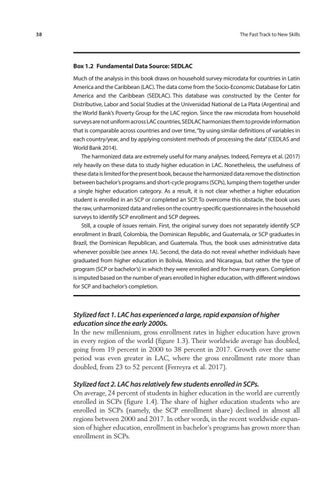38
The Fast Track to New Skills
Box 1.2 Fundamental Data Source: SEDLAC Much of the analysis in this book draws on household survey microdata for countries in Latin America and the Caribbean (LAC). The data come from the Socio-Economic Database for Latin America and the Caribbean (SEDLAC). This database was constructed by the Center for Distributive, Labor and Social Studies at the Universidad National de La Plata (Argentina) and the World Bank’s Poverty Group for the LAC region. Since the raw microdata from household surveys are not uniform across LAC countries, SEDLAC harmonizes them to provide information that is comparable across countries and over time, “by using similar definitions of variables in each country/year, and by applying consistent methods of processing the data” (CEDLAS and World Bank 2014). The harmonized data are extremely useful for many analyses. Indeed, Ferreyra et al. (2017) rely heavily on these data to study higher education in LAC. Nonetheless, the usefulness of these data is limited for the present book, because the harmonized data remove the distinction between bachelor’s programs and short-cycle programs (SCPs), lumping them together under a single higher education category. As a result, it is not clear whether a higher education student is enrolled in an SCP or completed an SCP. To overcome this obstacle, the book uses the raw, unharmonized data and relies on the country-specific questionnaires in the household surveys to identify SCP enrollment and SCP degrees. Still, a couple of issues remain. First, the original survey does not separately identify SCP enrollment in Brazil, Colombia, the Dominican Republic, and Guatemala, or SCP graduates in Brazil, the Dominican Republican, and Guatemala. Thus, the book uses administrative data whenever possible (see annex 1A). Second, the data do not reveal whether individuals have graduated from higher education in Bolivia, Mexico, and Nicaragua, but rather the type of program (SCP or bachelor’s) in which they were enrolled and for how many years. Completion is imputed based on the number of years enrolled in higher education, with different windows for SCP and bachelor’s completion.
Stylized fact 1. LAC has experienced a large, rapid expansion of higher education since the early 2000s. In the new millennium, gross enrollment rates in higher education have grown in every region of the world (figure 1.3). Their worldwide average has doubled, going from 19 percent in 2000 to 38 percent in 2017. Growth over the same period was even greater in LAC, where the gross enrollment rate more than doubled, from 23 to 52 percent (Ferreyra et al. 2017).
Stylized fact 2. LAC has relatively few students enrolled in SCPs. On average, 24 percent of students in higher education in the world are currently enrolled in SCPs (figure 1.4). The share of higher education students who are enrolled in SCPs (namely, the SCP enrollment share) declined in almost all regions between 2000 and 2017. In other words, in the recent worldwide expansion of higher education, enrollment in bachelor’s programs has grown more than enrollment in SCPs.

